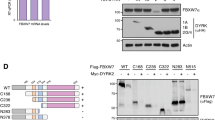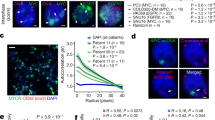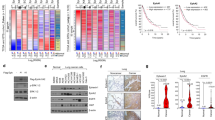Abstract
Gain-of-function mutation of the K-ras gene is one of the most common genetic changes in human tumors. In tumors carrying K-ras mutation, the presence of oncogenic K-Ras is necessary for maintenance of the transformed phenotype. ESXR1 is a human paired-like homeodomain-containing protein expressed primarily in the testis. In cells, the 65-kDa full-length ESXR1 protein is proteolytically processed into an N-terminal 45-kDa fragment containing the homeodomain, which localizes exclusively within the nucleus, and a C-terminal 20-kDa fragment consisting of a proline-rich repeat region, which is located in the cytoplasm. In this work, we demonstrated that the N-terminal ESXR1 fragment specifically recognizes the TAATNNNATTA P3 consensus sequence for the paired-like homeodomain and functions as a sequence-specific transcriptional repressor. We also showed that the N-terminal ESXR1 fragment binds to the TAATGTTATTA sequence present within the first intron of the human K-ras gene and inhibits its expression at both mRNA and protein levels. Ectopic expression of the N-terminal ESXR1 fragment in human carcinoma cells that carry mutated K-ras reduces the level of K-Ras and thereby inhibits the tumor cell proliferation. Identification of ESXR1 as a transcriptional repressor of K-ras has an important implication for the development of cancer therapy that inhibits oncogenic K-Ras expression.
This is a preview of subscription content, access via your institution
Access options
Subscribe to this journal
Receive 50 print issues and online access
$259.00 per year
only $5.18 per issue
Buy this article
- Purchase on Springer Link
- Instant access to full article PDF
Prices may be subject to local taxes which are calculated during checkout






Similar content being viewed by others
References
Adjei AA . (2001). J. Natl. Cancer Inst., 93, 1062–1074.
Andreyev HJN, Ross PJ, Cunningham D and Clarke PA . (2001). Gut, 48, 230–237.
Ashizawa S, Nishizawa H, Yamada M, Higashi H, Kondo T, Ozawa H, Kakita A and Hatakeyama M . (2001). J. Biol. Chem., 276, 11362–11370.
Bos JL . (1989). Cancer Res., 49, 4682–4689.
Brummelkamp TR, Bernards R and Agami R . (2002). Cancer Cell, 2, 243–247.
Caretti G, Salsi V, Vecchi C, Imbriano C and Mantovani R . (2003). J. Biol. Chem., 278, 30435–30440.
Fisher GH, Wellen SL, Klimstra D, Lenczowski JM, Tichelaar JW, Lizak MJ, Whitsett JA, Koretsky A and Varmus HE . (2001). Genes Dev., 15, 3249–3262.
Fohn LE and Behringer RR . (2001). Genomics, 74, 105–108.
Forrester K, Almoguera C, Han K, Grizzle WE and Perucho M . (1987). Nature, 327, 298–303.
Galiana C, Lozano JC, Bancel B, Nakazawa H and Yamasaki H . (1995). Mol. Carcinog., 14, 286–293.
Gehring WJ, Affolter M and Bürglin T . (1994). Annu. Rev. Biochem., 63, 487–526.
Higashi H, Tsutsumi R, Muto S, Sugiyama T, Azuma T, Asaka M and Hatakeyama M . (2002). Science, 295, 683–686.
Hoffman EK, Trusko SP, Freeman N and George DL . (1987). Mol. Cell. Biol., 7, 2592–2596.
Hruban RH, van Mansfeld ADM, Offerhaus GJA, van Weering DHJ, Allison DC, Goodman SN, Kensler TW, Bose KK, Cameron JL and Bos JL . (1993). Am. J. Pathol., 143, 545–554.
Johnson L, Greenbaum D, Cichowski K, Mercer K, Murphy E, Schmitt E, Bronson RT, Umanoff H, Edelmann W, Kucherlapati R and Jacks T . (1997). Genes Dev., 11, 2468–2481.
Johnson L, Mercer K, Greenbaum D, Bronson RT, Crowley D, Tuveson DA and Jacks T . (2001). Nature, 410, 1111–1116.
Jordano J and Perucho M . (1988). Oncogene, 2, 359–366.
Knudsen S . (2002). A Biological Guide to Analysis of DNA Microarray Data. John Wiley & Sons, Inc.: New York.
Levine M and Hoey T . (1988). Cell, 55, 537–540.
McIntyre A, Summersgill B, Jafer O, Rodriguez S, Zafarana G, Oosterhuis JW, Gillis AJM, Looijenga L, Cooper C, Huddart R, Clark J and Shipley J . (2004). Oncogene, 23, 9142–9147.
Meuwissen R, Linn SC, van der Valk M, Mooi WJ and Berns A . (2001). Oncogene, 20, 6551–6558.
Ozawa H, Ashizawa S, Naito M, Yanagihara M, Ohnishi N, Maeda T, Matsuda Y, Jo Y, Higashi H, Kakita A and Hatakeyama M . (2004). Oncogene, 23, 6590–6602.
Rodenhuis S, van de Wetering ML, Mooi WJ, Evers SG, van Zandwijk N and Bos JL . (1987). N. Engl. J. Med., 317, 929–935.
Summersgill BM, Jafer O, Wang R, Goker H, Niculescu-Duvaz I, Huddart R and Shipley J . (2001). Cancer Genet. Cytogenet., 128, 120–129.
Wilson D, Sheng G, Lecuit T, Dostatni N and Desplan C . (1993). Genes Dev., 7, 2120–2134.
Wolfes H, Kogawa K, Millette CF and Cooper GM . (1989). Science, 245, 740–743.
Wright WE, Binder M and Funk W . (1991). Mol. Cell. Biol., 11, 4104–4110.
Acknowledgements
We thank A Kakita, S Ashizawa, H Higashi, H Ozawa, K Yokoyama, T Ueno, J Hamada, S Takiya and H Meguro for technical assistance. This work was supported by grants-in-aid for science research from the Ministry of Education, Culture, Sports, Science and Technology (MEXT) of Japan.
Author information
Authors and Affiliations
Corresponding author
Rights and permissions
About this article
Cite this article
Yanagihara, M., Ishikawa, S., Naito, M. et al. Paired-like homeoprotein ESXR1 acts as a sequence-specific transcriptional repressor of the human K-ras gene. Oncogene 24, 5878–5887 (2005). https://doi.org/10.1038/sj.onc.1208736
Received:
Revised:
Accepted:
Published:
Issue Date:
DOI: https://doi.org/10.1038/sj.onc.1208736



